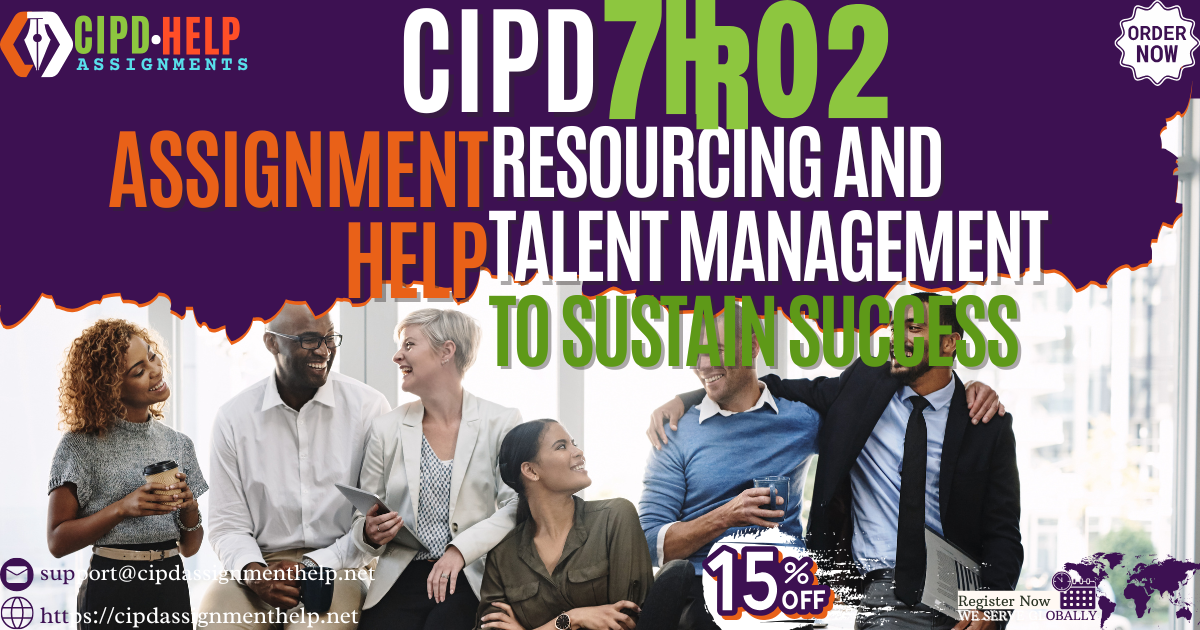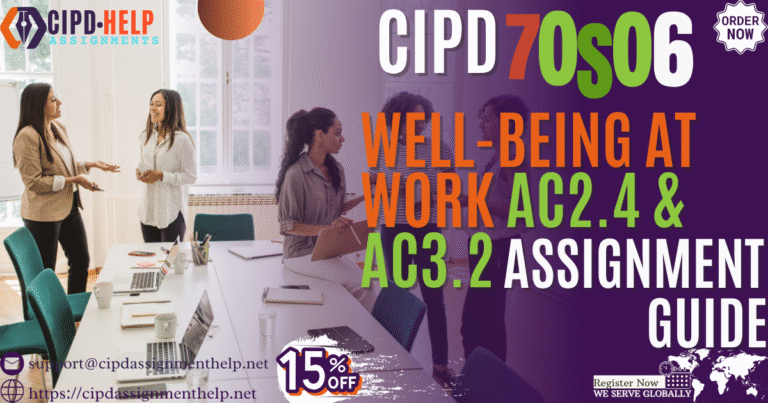7HR02 Resourcing and Talent Management to Sustain Success
There’s a lot riding on the decisions we make about people, who we bring into the organisation, how we support their growth, and whether they stick around. 7HR02 Resourcing and Talent Management to Sustain Success encourages us to think more practically, to weigh up what’s really working and what’s just theory. You might start out thinking it’s about policies or workforce planning, but then you find yourself asking trickier questions. Are we recruiting for skills, or just for fit? And what happens when we get it wrong?
Assessment Questions
CIPD research shows that across the world a large proportion of employers are continuing to experience skills shortages and recruitment difficulties. The findings of the 2023 People Profession survey highlight that workforce planning, employee engagement and retention, and the management of performance and productivity are some of the top people priorities. As a part of a periodic review of its people strategies your manager has asked you to lead a working party to examine and review the organisation’s resourcing and talent strategy that focuses on the following questions.
For the purpose of this assessment, you need to apply your answers to either your own organisation or one with which you are familiar. It is essential that your reading of the published literature is used to inform your responses to all questions.
Reviewing Resourcing and Talent Strategy in Response to Internal and External Factors
Question 1 (AC 1.1): Analyse one external and one internal factor that is shaping the organisation’s resourcing and talent strategy. Recommend how this strategy could be improved to respond to these factors.
When we talk about resourcing and talent strategy, it’s rarely a fixed thing. It shifts, sometimes quite drastically, depending on pressures both inside and outside the organisation. Lately, those pressures seem to be intensifying. From what we’ve seen in the CIPD 2023 People Profession survey, the skills shortage isn’t letting up. That’s not just a UK problem, it’s global. And it’s not going away soon.
External Factor: A Difficult and Changing Talent Market
Shrinking Candidate Pools
Let’s start with an external factor that’s having quite a noticeable effect. The talent market itself. Or, more specifically, the scarcity of certain skillsets. Whether it’s experienced tradespeople, digital specialists, or healthcare workers, the talent pool in many areas feels thin. And employers aren’t always able to offer what candidates are asking for, not just in terms of salary, but flexibility, purpose, development, and more.
Rising Expectations from Applicants
For an organisation I’ve worked closely with in the care sector, this issue has meant struggling to fill vacancies for roles that used to attract dozens of applicants. The problem isn’t just fewer candidates, it’s the expectations they bring. They want more say over shifts. They care deeply about workplace culture. They often ask about training pathways before they even mention pay. And sometime, they just don’t apply at all.
Strategic Response: Rethinking What “Attractive” Means
How could this be addressed? One response might be to re-think what “attractive” means from a candidate’s perspective. It might involve offering part-time contracts with more predictability, or building in proper mentorship for new starters. A recruitment strategy focused only on advertising more widely may not be enough anymore, not when the problem is about appeal, not just reach.
Internal Factor: The Cycle of Turnover and Organisational Culture
Ongoing Staff Turnover
Turning to an internal factor, one that continues to shape resourcing decisions is the organisation’s own turnover rates. In some teams, turnover is manageable. In others, particularly front-line roles, it’s high and constant. And that creates a feedback loop. People leave, the pressure increases for those who remain, morale drops, and then more leave. It’s tiring to manage, and even harder to plan around.
Staff Sentiment and Voice
Part of the challenge is cultural. Some staff don’t feel heard. Others say career progression seems murky or limited. And while there are exit interviews, they often don’t tell us anything we didn’t suspect already.
Strategic Response: Focusing on Retention to Support Recruitment
What could change? Perhaps the first thing is to acknowledge that retention and recruitment aren’t separate. One can’t work without the other. Making the effort to understand what keeps people, not just what attracts them, might shift things. That might mean piloting regular stay conversations or reviewing how performance conversations are being used. It might even mean loosening rigid promotion structures in favour of more fluid development opportunities.
None of this is simple. And not every suggestion will stick. But it’s these kinds of questions, often a little uncomfortable, that help shape a resourcing and talent strategy that can actually hold up under pressure. We don’t need something perfect. Just something responsive, and maybe even a bit more human.
Improving Employee Induction through Realistic Recommendations and Evaluation
Question 2 (AC 2.4): Make two justified recommendations as to how the organisation can improve the effectiveness of its employee induction programme and propose how its effectiveness can be evaluated.
Starting a new job is rarely straightforward for anyone. No matter how confident someone might seem on the outside, stepping into a new environment, learning new systems, and figuring out how things are really done around here can be overwhelming. That’s where induction, or onboarding, plays such a vital role. Yet, despite its importance, many organisations still treat it as a box-ticking exercise.
In reviewing how we currently support new joiners in their first weeks, a few things stand out. There’s the paperwork, it gets done. Then there are the meetings, some helpful, some not. And then? Most new hires are left to figure out much of the rest on their own. It’s not that we don’t care; perhaps we’ve just assumed people will settle in naturally. But that assumption could be costing us. Staff who don’t feel settled quickly tend to disengage or leave within the first few months. And that’s not just frustrating, it’s expensive.
First recommendation: Assign informal mentors
One way to make a genuine difference might be surprisingly simple: pair each new starter with a peer buddy, not necessarily a line manager or someone in HR, but a colleague who’s been around for a while, understands the ropes, and has the patience to walk someone through the informal bits of workplace life. Things like “where’s the good coffee?” or “how do we actually request time off?” These small things matter more than we admit. It’s about easing someone into the social fabric of the team. And we’ve seen, even anecdotally, how much more comfortable new hires become when they have a go-to person from day one. They ask more questions. They engage faster. They smile more.
Second recommendation: Spread induction over time
Another change worth considering, stretching induction over a longer period. Rather than trying to frontload everything into week one, which no one really remembers anyway, what if we staggered it across the first month or two? Introduce systems and policies gradually, allow space for reflection, and build in time to shadow others at a manageable pace. The idea here isn’t to overwhelm, but to build confidence slowly. Give people time to breathe. Let them try, fail, ask. Then return with better questions. Some might argue that this risks delays in productivity, but the opposite often happens. With better grounding, people contribute more meaningfully and sooner.
Evaluating effectiveness
Now, how do we know any of this works? Honestly, it’s hard to measure feelings, but we can still try. Pulse surveys, timed check-ins at week one, week four, and month three could be helpful. Not big surveys, just three or four questions, quick to complete. Ask how supported they feel, whether they understand their role, and if they’ve connected with their team. We might even pick up early warning signs of someone drifting. A final thought? Ask the ones who left early. It’s uncomfortable, sure. But sometimes the truth sits quietly in the exit interview drawer, waiting for someone to read it.
Evaluating Short and Long-Term Approaches to Workforce Planning
Question 3 (AC 3.1): To further enhance the organisation’s workforce planning, evaluate a short and a long-term approach that could be implemented to meet the current and future demand for talent, providing justification for why each would be appropriate.
When asked to consider how we might prepare for the organisation’s future talent needs, it’s easy to get lost in spreadsheets and forecasting models. But if we pause for a moment, think about the real people behind the numbers, it becomes clearer that this isn’t just about filling roles. It’s about shaping a workforce that’s able to keep pace with the demands of the present, while preparing for what’s next. This is where short and long-term workforce planning approaches both come into play, and while they serve different purposes, they often overlap more than we expect.
A Short-Term Approach: Talent Pooling and Internal Redeployment
Let’s begin with something immediate. Many of us have seen departments under pressure, suddenly understaffed, struggling to meet demand. And yet, across the corridor, another team might be quieter than usual. Short-term talent solutions don’t always mean hiring. Sometimes, it’s about looking inwards.
One practical option is building and maintaining a live internal talent pool, supported by skills audits and staff development records. If we know who can do what, we can move people quickly when demand shifts. It’s not always smooth, someone might need a day or two of brushing up, or there may be resistance to stepping outside comfort zones, but it works. We’ve trialled this in our service desk team, reassigning staff to field calls during seasonal spikes. It wasn’t perfect, but it did the job. And in most cases, those secondments sparked broader learning, even unplanned upskilling.
There’s also the option of short-term contracts or temporary hires to plug gaps. But it can be expensive, and it rarely builds long-term loyalty. That’s why internal redeployment, though slower at first, often feels more grounded.
A Longer-Term Approach: Workforce Forecasting and Career Pathway Planning
Longer-term thinking, by contrast, requires more patience and some comfort with uncertainty. We’re not just looking at what we need today, or even next quarter, we’re asking who our organisation will need in five years, and whether those people exist within reach.
One option here is workforce forecasting tied closely to business goals. If the strategy points toward digital expansion, for example, then we’ll need to consider how many cybersecurity specialists or data analysts we might require, and where they’ll come from. But forecasting can feel speculative. Assumptions change. Strategies shift. So, while it’s a useful exercise, it shouldn’t be the only lens.
Another layer might be developing career pathways within the organisation. This is less about promotions and more about preparing people for future roles, gradually. We’ve been testing this in the health and safety team, identifying junior staff with the potential to grow into specialist posts. That process involved mentoring, gradual exposure to different tasks, and a lot of patience. Not everyone stayed on the path—but some did. And those who did now form part of our medium-term pipeline.
In truth, neither approach, short nor long-term is without its faults. The short-term sometimes feels rushed. The long-term occasionally loses touch with reality. But when paired with honest reflection and consistent dialogue with staff, they form a kind of rhythm. One responds to the moment; the other nudges us forward. And between the two, something more balanced begins to take shape.
Evaluating Two Contemporary Technology-Based Methods for Managing Individual and Team Performance
Question 4 (AC 4.2): Within the context of the organisation, evaluate two contemporary methods that utilise technology to manage both individual and team performance.
When reviewing how technology now fits into performance management, there’s no single approach that feels universally “right.” In fact, depending on the organisation, the culture, and even the team setup, what works for one may fall flat in another. In our context, a mid-sized service company with a growing remote workforce, this question has been part of several recent strategy sessions.
1. Real-Time Performance Monitoring Tools
One area that keeps coming up is real-time performance monitoring. It’s not exactly new, but the way tools are now being used has changed quite a bit. Previously, it was all about output: how many calls answered, emails responded to, deadlines hit. But now, we’re seeing platforms that combine metrics with behavioural data. Not to spy, but to give line managers a broader picture, things like engagement patterns, responsiveness, or collaboration frequency. Some of us had our doubts at first. Would it make people feel micromanaged? Possibly. But when used with care, say, as a conversation starter rather than a stick, it’s helped some team leaders flag early signs of disengagement or burnout.
In one department, a simple dashboard helped uncover that a team member who seemed “underperforming” was actually overworked, handling more queries than the rest but not logging them properly. It wasn’t about blame, more a chance to rebalance the workload. That’s the bit that sometimes gets missed, these tools are only as good as the conversations they spark. They can’t tell the full story, but they give you a clue where to look.
2. 360-Degree Feedback Platforms with AI Analysis
The second method we’ve looked at is structured 360-degree feedback systems that now use AI to identify patterns. This one’s a bit divisive. On one hand, it opens up performance discussions to a wider circle, managers, peers, even clients, depending on the role. That adds depth. But the real shift comes when AI is brought in to scan the feedback for trends, sentiment, consistency, or even blind spots in how someone views their own performance compared to others’ perceptions.
One of our teams trialled this after a leadership training cohort, and the reflections it triggered were mixed. Some found it useful, eye-opening even. One colleague said she didn’t realise how often she interrupted people during meetings until it appeared in six out of nine responses. Others felt a bit over-analysed, like they were being dissected. There’s a balance to strike here. Feedback should remain human, even if tech is doing the sorting.
What’s tricky about these methods is they seem objective, data-driven, analytical, but they rely on context, interpretation, and how they’re introduced to the workforce. Technology can point us to issues, but it doesn’t solve them. There needs to be room for dialogue, and a bit of discomfort too. Otherwise, we just collect more data without ever changing much. That’s something we’re still learning, to be honest.
Frequently Asked Questions
1. What is the main focus of 7HR02?
It centres around understanding how people decisions impact long-term business performance, especially recruitment, retention, and development strategies. The course also prompts reflection on how those choices affect teams on the ground.
2. Is 7HR02 theory-heavy or practical?
It leans more towards practical thinking. There’s theory, of course, but it often serves as a backdrop. The main focus is usually on making sound, people-related decisions in messy, unpredictable contexts.
3. What kind of assignments are involved in 7HR02?
Expect to write a report that digs into real resourcing challenges. You’ll likely explore case scenarios, critique certain practices, and recommend something more grounded, nothing too abstract or textbook-like.
4. How does this unit tie into overall HR practice?
It’s connected to day-to-day realities in recruitment, retention, and workforce planning. You’ll probably find that it shifts how you approach performance, engagement, and turnover conversations at work.
5. Do I need a lot of HR experience to succeed in 7HR02?
Not necessarily. But it helps to bring in examples from your own workplace. If you’ve seen a good (or bad) hiring decision play out over time, you’re halfway there.





